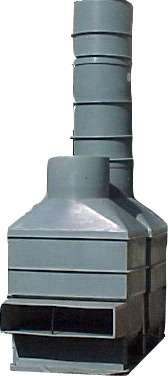


The Combined Cycle Air Conditioner CCAC is a new air conditioning system. Substantial energy savings are achieved, compared to conventional air conditioners, especially in humid areas.
It is applied efficiently in cold winter and can operate and heat properly at temperatures much lower than those of conventional air conditioners (even at ambient tempratures of -15°C).

The CC7 combines two small and advanced air-to-brine heat exchangers (left and right units in the picture), scroll-type refrigerant compressor, evaporator, and condenser.
The enclosure air is induced into the brine-to-air heat exchanger (left-hand unit), where it transfers heat and vapor to the cold brine. The compressor pumps this heat into the condenser, where the heat of refrigerant condensation is transferred to the brine. From the brine the heat is transferred to the ambient air at the right-hand unit. In the process, the brine at the left-hand unit is diluted by water vapor while the brine in the right-hand unit is concentrated by evaporation.
This product is protected by U.S. patent no. 6,018,954 and by Israel patent no. 113446.

Definitions:
1. Humidity load: Load due to latent heat of vapor condensation in cooling mode and evaporation in heating mode.
2. Sensible load: Load due to change of air temperature.
Saving 25% of energy compared to conventional air conditioners in arid zones, where sensible heat is dominant.
Saving more than 50% of energy when humidity loads are higher than sensible loads, if the relative humidity is low.
Heating and operating properly even at ambient temperature of -15°C.
7 ton of cooling (24 kW cooling)
COP=4 for fresh air conditioning

The following tables show examples of operation with the CCAC and with conventional air conditioners.
1. Summer – cooling mode
General conditions:
Ambient: 35°C, RH=40%NOTE:
Inside: 27°C, RH=50%
LL – Humidity/Latent loadTable 1: Latent load is 50% of the total load
SL – Sensible load
Total load = LL + SL
|
|
|
|
| LL, kW (kg vapor/hour) |
|
|
| SL, kW. |
|
|
| TL, kW. |
|
|
| Power input, kW |
|
|
| COP |
|
|
Table 2: Climate conditions as in table 1, latent load is 25% of the total load
|
|
|
|
| LL, kW (kg vapor/hour) |
|
|
| SL, kW. |
|
|
| TL, kW. |
|
|
| Power input, kW |
|
|
| COP |
|
|
Table 3: Fresh air conditions. Climate conditions as in table 2, latent load is 60% of the total load (result of fresh air conditions)
|
|
|
|
| LL, kW (kg vapor/hour) |
|
|
| SL, kW. |
|
|
| TL, kW. |
|
|
| Power input, kW |
|
|
| COP |
|
|
The following graph summarizes the tables.

Horizontal coordinate is ratio of latent load to total load.
Left vertical coordinate is COP of the air conditioners.
It is clear that the CCAC is better than the conventional air conditioner throughout the range of operation. The advantage increases sharply with the increase in latent load to total load ratio.
2. Winter – heating mode
General conditions:
Ambient: 0°C, RH=80%
Inside: 22°C, RH=50%
|
|
|
|
| LL, kW (kg vapor/hour) |
|
|
| SL, kW. |
|
|
| TL, kW. |
|
|
| Power input, kW |
|
|
| COP |
|
|
The table simplifies matters, showing COP ratio of 1.55. But, the CCAC is even much better, taking into consideration the following factors:
1. The CCAC adds humidity to the room, whereas additional humidification at a rate of about 6 kg/hr is required with conventional air conditioner or space heater. This is needed to prevent human body stresses associated with low humidity.
2. The conventional air conditioner cannot operate continuously at the conditions described in table 4. Its operating cycle is intermittently reversed in order to defrost the outdoor unit. Heat is pumped to the ambient during this process, lowering the average COP even further.

Unit length: 2100 mm
Unit Width: 1024 mm